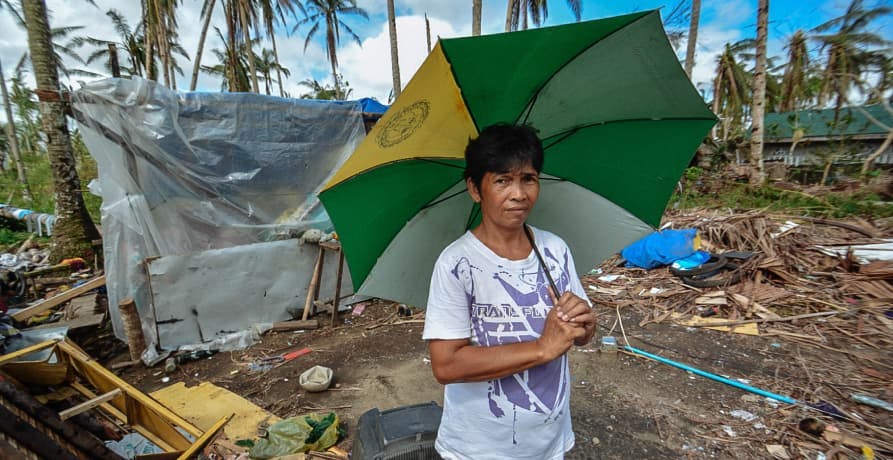ESG / CSR
Industries
How can we increase our climate resilience?



Climate resilience - the ability to prepare for, recover from, and adapt to the impacts of climate change - has become a critical priority in today’s warming world.
Even if we succeed in reducing global emissions, we can’t reverse the damage already done. From rising sea levels to heatwaves and wildfires, the effects of climate change are here - and they’re only intensifying. That’s why mitigation isn’t enough on its own. We also need to adapt, and that means building stronger climate resilience.
- What climate resilience actually means
- Why it matters alongside climate change mitigation
- The biggest challenges to implementing climate adaptation
- Real-world strategies and success stories from around the globe
- What effective, long-term resilience looks like and who’s responsible for making it happen
What is climate resilience? A quick overview
Climate resilience is the ability of people, communities, and systems to anticipate, prepare for, recover from, and adapt to the impacts of climate change.
Even with strong emissions reductions, many climate impacts, like extreme heat, floods, droughts, and rising sea levels, are now unavoidable. That’s why resilience is essential: it helps minimise harm, protect lives and livelihoods, and ensure long-term stability.
Why climate resilience is essential – even if we cut emissions
There’s often a misconception that if we reduce or stop emissions now, the climate crisis will quickly begin to resolve itself. But the reality is more complex.
Our climate system doesn’t respond instantly. Greenhouse gases like CO2 stay in the atmosphere for decades, some even centuries, continuing to trap heat long after emissions stop. That means many of the impacts we’re seeing now will intensify before they stabilise, even under the most ambitious climate targets.
Some changes are already “baked in” because of:
Why some climate impacts are already unavoidable:
- Thermal inertia: the ocean and atmosphere take time to fully respond to heat already absorbed
- Slow feedback loops: like melting permafrost or declining ice sheets, which continue to accelerate even with mitigation
- Ecosystem thresholds: once crossed, these can trigger lasting or irreversible change
So while it's crucial to cut emissions and prevent further damage, we also need to prepare for the unavoidable impacts that are already unfolding due to our changing climate.
Here’s a closer look at the climate consequences we’re already experiencing or are now inevitable, even if emissions drop dramatically:
| Climate impact | Description | Why it’s unavoidable | Resilience implications |
|---|---|---|---|
|
Sea level rise
|
Oceans have already risen 20 cm since 1900, threatening coastal cities and small islands. | Driven by locked-in glacier melt and thermal expansion of warming seas. | Coastal infrastructure needs upgrading; managed retreat or flood defence plans must be implemented. |
|
Melting glaciers & ice sheets
|
Accelerated melting in Greenland and Antarctica is already contributing to sea level rise. | Melt continues due to past warming; feedback loops (e.g. darker surfaces absorbing heat) worsen it. | Affects water supplies in regions dependent on glacier-fed rivers (e.g. Andes, Himalayas). |
|
Hotter, more frequent heatwaves
|
Severe heat events are increasing in duration and intensity. | Global average temperatures have already risen 1.1°C; urban heat island effects worsen this. | Cities need cooling infrastructure, early warning systems, and support for vulnerable populations. |
|
Shifting rainfall patterns
|
Some areas face prolonged drought; others see intense rainfall and flooding. | Warming changes evaporation and precipitation patterns, increasing climate variability even without future emissions. | Water management and crop diversification are essential in both drought-prone and flood-prone areas. |
|
More wildfires
|
Longer fire seasons and larger, more destructive blazes in regions like California, Australia, and southern Europe. | Hotter, drier conditions are already becoming the new normal in many areas. | Land use management, early response strategies, and fire-adapted infrastructure are key. |
|
Ocean warming & acidification
|
Coral reefs are bleaching, and marine ecosystems are under threat. | CO₂ absorption causes warming and chemical changes in the ocean that continue regardless of new emissions. | Fisheries, tourism, and marine biodiversity are at risk; sustainable coastal economies need adaptation plans. |
|
Biodiversity loss
|
Habitat loss and species migration are disrupting ecosystems. | Temperature and habitat shifts are already beyond historical norms. | Conservation strategies must be adaptive and region-specific. |
|
Climate-related displacement
|
People are already being forced to migrate due to climate extremes. | Sea level rise, desertification, and crop failure are already happening. | Governments must prepare legal and infrastructure support for climate migrants. |

What’s standing in the way of climate resilience?
We know that resilience is essential to cope with the climate impacts already unfolding, but putting it into practice is easier said than done. Despite growing awareness, real progress is often slowed by structural, financial, and political barriers.
From lack of funding to the absence of long-term planning, these challenges can delay or derail the measures needed to protect people, infrastructure, and ecosystems.
Here are some of the key obstacles holding back climate adaptation today:
One of the toughest challenges is that climate-related events are hard to forecast with precision. Extreme weather doesn’t follow neat patterns, and that makes long-term planning incredibly difficult.
This uncertainty limits governments’ and organisations’ ability to prepare in advance, and can also delay or complicate emergency response when disaster strikes.
Plus, the scale and complexity of many climate impacts - extreme weather events like mega-droughts or regional flooding - often exceed the capacity of any single organisation to handle alone.
Adaptation efforts can be held back by either a lack of supportive legislation or by existing laws that unintentionally get in the way.
In some cases, outdated land-use policies or building codes make it difficult to implement climate-smart infrastructure. In others, the political will to update regulations simply isn’t there, especially where maintaining the status quo benefits certain economic interests.
To be effective, climate resilience planning must be backed by clear regulations, consistent government policies, and collaboration with relevant organizations – all within the framework of sustainable development.
Building resilience comes with a price tag, and adaptation doesn’t always make it to the top of the funding list.
Governments and businesses are often juggling more immediate concerns, which means long-term climate planning can get pushed aside. And because resilience projects don’t always show quick returns, they’re less likely to attract private investment unless backed by strong incentives or public funds.
This is especially true in lower-income countries, where the need for adaptation is greatest but financial resources are most limited.
Resilience planning requires deep technical knowledge, cross-sector expertise, and access to advanced tools - from climate modelling to real-time monitoring systems.
In many regions, especially in developing nations, there’s a shortage of the skills and technologies needed to design and deliver effective adaptation strategies.
This creates a widening gap between those who can afford to prepare and those who are most vulnerable to the impacts.
Climate resilience is all about acting before a crisis hits, but that kind of forward-thinking isn’t always easy to sell.
In places where the impacts of climate change aren’t yet visible or severe, decision-makers may delay adopting policies or investing in problems that feel distant. But by the time the effects are unavoidable, it’s often too late to avoid major losses.
Planning ahead saves lives, livelihoods, and long-term costs, but it requires a shift in mindset: from short-term thinking to long-term resilience.
Climate resilience strategies: How do we actually build it?
Building climate resilience means moving from awareness to taking steps toward action. While climate mitigation focuses on preventing further change, adaptation refers to the ways we learn to live with the change that’s already happening and prepare for what’s still to come.
The Intergovernmental Panel on Climate Change (IPCC) defines adaptation as:
In practice, this means developing the tools, systems, and behaviours that allow us to respond effectively to climate disruption.
Adaptation strategies generally fall into two broad categories:
1. Building adaptive capacity
This is about laying the groundwork, putting the right knowledge, infrastructure, and systems in place so that adaptation can happen efficiently and equitably.
Key components include:
Data, research, and early warning systems
Investing in climate monitoring, risk modelling, and localised impact data
Developing early warning systems for extreme events like floods, storms, and heatwaves
Sharing open-source climate data to support decision-making at all levels
Resilient infrastructure and planning
Designing the built environment (buildings, roads, and public spaces) to withstand climate hazards such as extreme weather
Retrofitting existing infrastructure (eg. elevating homes, waterproofing power stations)
Updating urban planning and zoning to reflect future climate risks (eg. avoiding development in flood-prone areas)
Governance and institutional support
Creating policies, regulations, and legal frameworks that prioritise adaptation
Mainstreaming resilience into national development plans and budgets
Building institutional capacity across sectors (from transport to healthcare)
Education, training, and community engagement
Promoting climate literacy and risk awareness across all levels of society
Supporting vocational training for climate-smart agriculture, water management, environmental management, and engineering
Involving local communities - especially Indigenous peoples and marginalized communities - in decision-making
2. Delivering adaptation actions
Once adaptive capacity is in place, the next step is to implement targeted actions that reduce vulnerability, avoid harm, and limit the damage from climate impacts.
Examples of effective adaptation actions include:
Nature-based solutions
Restoring wetlands, mangroves, and forests to act as natural buffers
Encouraging agroecological farming methods that improve soil health and drought resilience
Protecting biodiversity and ecosystem services critical to climate stability
Climate-resilient agriculture
Shifting to drought-resistant or salt-tolerant crops
Redesigning irrigation systems to maximise water efficiency
Providing farmers with access to climate forecasts, insurance, and financial tools
Water and flood management
Expanding green infrastructure, like installing green roofs, rain gardens, permeable pavements, and retention basins
Investing in flood barriers, drainage upgrades, and river restoration projects
Developing contingency plans for drought-prone regions
Health and social protection systems
Strengthening healthcare systems to manage climate-related illnesses (eg. heat stress, vector-borne diseases)
Expanding social safety nets and climate risk insurance for vulnerable populations
Developing emergency response plans for climate disasters

Climate resilience in the UK
From rising coastal erosion in Norfolk to flash floods in London, the UK is already feeling the pressure of a warming world. And while mitigation targets have often made headlines, adaptation has historically lagged behind.
The UK’s adaptation strategy
The government’s main plan for tackling climate risks is the National Adaptation Programme (NAP3), launched in 2023. It outlines how the UK will address key climate risks identified in the Climate Change Risk Assessment (CCRA), such as:
- Increased flood and coastal erosion risk
- Threats to food security and water supply
- Health impacts from heat and air pollution
But while NAP3 is a step forward, many experts say it lacks the urgency and funding needed to keep pace with rising risks. The Climate Change Committee (CCC) (the UK’s independent climate watchdog) warned that progress on adaptation remains “too slow" with no comprehensive delivery plan or strong accountability mechanisms in place.
What does climate resilience look like in action?
Despite these challenges, there are pockets of progress across the UK. A few examples:
Key challenges
But the UK’s path to resilience is far from smooth. Some of the main barriers include:
- Funding gaps: Many local authorities lack dedicated budgets for adaptation.
- Fragmented governance: Adaptation responsibilities are spread across agencies with limited coordination.
- Public awareness: While climate change is widely understood, knowledge of localised risks – like overheating homes or flash flood zones – is still limited.
Principles of effective climate resilience
So, what does good climate resilience actually look like in practice? To guide governments, businesses, and communities in designing smart adaptation strategies, the World Bank developed a widely referenced framework:
The Adaptation Principles: A Guide for Designing Strategies for Climate Change Adaptation and Resilience.
The report sets out six key principles that can be applied universally, no matter the country, region, or sector. Together, they provide a solid foundation for shaping long-term, inclusive, and effective adaptation efforts.
Here’s a breakdown of the six principles:
International efforts to support climate resilience
While climate resilience needs to be built locally, international support plays a critical role, especially when it comes to funding, knowledge-sharing, and technical assistance.
A number of global and regional initiatives - from multilateral banks to international organizations - have been set up to help countries adapt, often as part of broader sustainable development programmes. Below is a quick overview of the main frameworks driving international climate resilience efforts:
| Initiative | What it supports | Latest updates |
|---|---|---|
| Green Climate Fund (GCF) | Funds large-scale adaptation and mitigation projects in developing countries | Approved $687m in early 2025 for forest resilience and water security projects |
| Pilot Program for Climate Resilience (PPCR) | Integrates climate resilience into national development plans | Focuses on highly vulnerable countries across Africa, Asia, and the Caribbean |
| Global Environment Facility – LDCF | Supports adaptation in the least developed countries (LDCs) | Over its first 20 years, the LDCF has disbursed approximately $1.65 billion in grants to support climate adaptation projects |
| International Climate Initiative (IKI) | Funds ecosystem-based adaptation and climate governance | Active in emerging economies; focuses on biodiversity and capacity-building |
| Coalition for Disaster Resilient Infrastructure (CDRI) | Strengthens infrastructure planning to withstand climate shocks | Backed by 39 countries, UN agencies, and development banks |
| UNESCO Climate Information Fund | Supports Global South organisations in improving climate data integrity | Offers grants of $30k–150k for NGOs and research initiatives |
Climate resilience takes funding, and not enough is coming through
Building climate resilience takes more than policy plans or international declarations. From upgrading infrastructure to supporting vulnerable communities, adaptation requires long-term, large-scale investment. And right now, the money isn’t flowing fast enough.
While developed nations technically met their $100 billion climate finance pledge in 2022, most of that funding still goes to mitigation projects that reduce emissions. Adaptation, by contrast, receives just 20–25% of total climate finance, despite being a lifeline for countries already on the front lines of climate change.
According to the United Nations, developing countries will need between $215 and $387 billion per year by 2030 to meet their growing adaptation needs. Current flows fall far short of that, leaving a growing and dangerous funding gap.
This shortfall hits hardest in regions that have contributed least to global emissions. Across the Global South, countries are already dealing with sea level rise, drought, and extreme weather, but without the resources to prepare or recover.
Without funding, communities can’t build the infrastructure, services, or safety nets they need to stay safe and thrive. The risk of deepening inequality and climate-driven displacement is growing by the year.
Many local governments and community organisations face major hurdles accessing international climate funds. Application processes are often complex, with strict eligibility rules and burdensome reporting requirements.
At the same time, private investors have been slow to engage. Adaptation projects tend to offer uncertain returns over long timelines, and without stronger incentives or frameworks, most remain underfunded.
New tools like the Climate Resilience Investment Framework (CRIF) and disclosure standards from the Task Force on Climate-related Financial Disclosures (TCFD) are helping investors assess physical climate-related risks, while adaptation-focused green bonds are being developed to unlock capital for resilient infrastructure.
Blended finance models - where public and private funding is combined - are also gaining ground, particularly in agriculture, where climate-smart solutions are urgently needed.
But these efforts are still too small to meet the scale of the challenge.
If climate resilience is to become a reality, developed nations need to go beyond pledges. That means not only scaling up climate finance for adaptation, but ensuring it’s accessible, equitable, and sustained over the long term.
Without that commitment, communities most at risk will continue to face the consequences of a crisis they did little to create, without the tools to protect themselves.
Climate resilience in action: real-world success stories
To see how climate adaptation can make a meaningful difference, it helps to look at real examples. The following case studies show how targeted interventions, when well-designed and well-funded, can improve lives, reduce vulnerability, and build long-term resilience.
Ethiopia: Social Safety Net Programme
In 2006, the Ethiopian government, with support from international partners, launched the Productive Safety Net Programme (PSNP), a major initiative to tackle food insecurity worsened by climate change impacts such as drought and flooding.
The programme provides cash or food assistance to vulnerable households, but there’s a long-term element too. In exchange for this support, participants engage in environmental restoration projects, including land rehabilitation and water infrastructure improvements.
The results speak for themselves:
- Beneficiaries experienced a 25% smaller drop in food consumption during floods than non-participants
- Soil loss was reduced, helping stabilise agricultural productivity
- Access to safe drinking water increased, helping to combat water scarcity, and degraded land has been brought back into productive use
It’s a strong example of how social protection and environmental goals can go hand in hand, delivering resilience on multiple fronts and serving as a model of best practice for other climate-vulnerable nations.
India: Centralised cooling in Gujarat
With increasing temperatures and heatwaves in India growing hotter and longer due to climate change, the Gujarat International Finance Tec-City (GIFT City) is pioneering a large-scale adaptation solution: a centralised air conditioning system designed for energy efficiency and accessibility.
Instead of each building installing its own system, GIFT City is implementing a district cooling network that delivers chilled water through underground pipes to multiple buildings.
This approach:
- District cooling can cut energy use by up to 50% compared to conventional AC systems
- Reduces upfront costs for building owners and tenants
- Helps limit emissions from cooling - a sector that’s expected to surge as temperatures rise
The project shows how urban design can adapt to extreme heat while avoiding the rebound effect of higher emissions, a model for other rapidly growing cities in hot climates.
The future of climate resilience
Building climate resilience is essential if we’re to minimise the unavoidable impacts of climate change and protect the world’s most vulnerable communities. But delivering meaningful adaptation is not without challenges – it’s complex, costly, and depends on long-term investment and coherent climate policies from governments and institutions.
What is certain, however, is that climate change is already disrupting lives and livelihoods around the world, often hitting hardest in places that contributed least to the crisis. This makes international cooperation and funding not just important, but urgent.
What about Greenly?
At Greenly, we help companies take control of their environmental impact with a full suite of carbon management and sustainability services.
- Measure your carbon footprint across all scopes
- Identify and implement effective emissions reduction strategies
- Conduct product-level Life Cycle Assessments (LCAs)
- Engage your suppliers and improve the sustainability of your value chain
- Stay ahead of evolving reporting requirements and climate regulations
Whether you're preparing for upcoming disclosure rules or simply want to build a more responsible business, Greenly gives you the tools and support to get there.
Ready to take the next step? Book a free demo with one of our climate experts - no commitment required.








